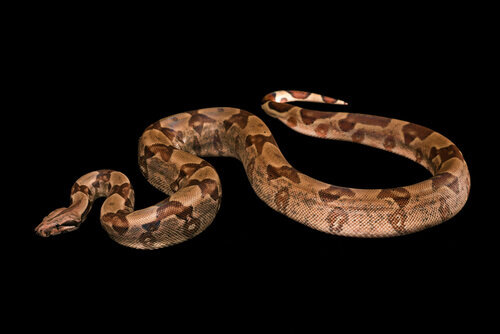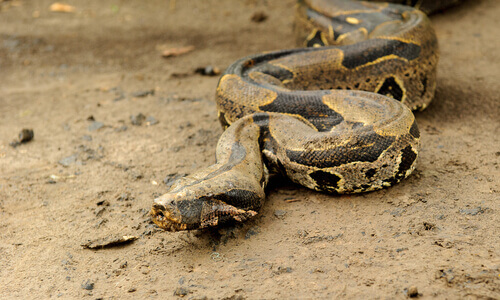Boa Constrictor: Characteristics, Behavior, and Habitat

The boa constrictor is one of the main members of the boa family. Boas are one of the most well-known types of constrictor snakes. These animals, unlike their close cousins the pythons, are American animals.
Since it lives in many Latin American countries, the boa constrictor has received various names in Spanish. From mantona in Peru to matacaballos in Ecuador, limacoa in Mexico, or mazacuata in Central America.
Characteristics of the boa constrictor
As there are multiple subspecies of boa constrictors, their sizes vary widely. Some boas measure under 2 feet and others exceed 13 feet; as in other reptiles, the females are usually larger than the males; an example of this is one of the specimens at the San Diego Zoo, which measures eighteen feet.
In all its variants, the boa constrictor has a coloration of reddish and brownish tones on the back. These are irregularly shaped and painted on the skin, which is usually brown or golden, although it can even be white. Like the royal python, crossbreeding in captivity has resulted in colors that are virtually never seen in the wild.
Boa constrictors usually live around 20 years in the wild, although, in captivity, there are specimens of 30 and even 40 years of age, thanks to veterinary care and diet control. As for their weight, constrictor snakes are massive animals and can reach some 65 or even 90 pounds in weight.

Boa constrictor behavior
Like most snakes, boa constrictors are solitary and nocturnal, so they’re not usually recommended as pets except for experienced reptile breeders.
These animals spend the day hiding in branches and hollows and often plan their nocturnal ambushes from trees. In addition, the boa constrictor swims quite well, so it’s not uncommon to find it submerged in swamps.
Like other ophidians, snakes like the boa constrictor have very poor vision, but have lip pits to detect its prey by heat, so that’s the secret to it being a great nocturnal hunter.
The boa constrictor consumes all kinds of prey, from opossums to rats, or even bats. Being a constrictor snake, it kills its prey in this way: it coils its rings around its prey after having bitten it, which kills the animal by asphyxiation.
As for reproduction, females use pheromones to attract males. Interestingly, females increase their melanin after copulation to darken their skin, which allows them to capture more heat.

It’s important to note that the boa constrictor is an ovoviviparous animal. That is, its eggs hatch inside the mother, and the snakes come out of her alive as if it were a mammal birth.
Boa constrictor habitat
This animal lives in areas with little water, such as savannas and deserts. However, the different subspecies of boa constrictors can also be found in jungles and cultivated areas, as they are terrestrial animals but sometimes use trees as their main habitat.
Specifically, these animals live from Argentina to Mexico, in countries such as Peru, Brazil, Paraguay, and Ecuador. The boa constrictor has become a very popular pet, which has meant that many of them have been captured in their habitat. However, these days, most of this market is fed by animals born in captivity.
People also hunt them for their skin and meat. Despite this, they’re vital for controlling opossum populations, which spread leishmaniasis in many of these areas, as well as controlling rodents that prey on human crops.
This text is provided for informational purposes only and does not replace consultation with a professional. If in doubt, consult your specialist.